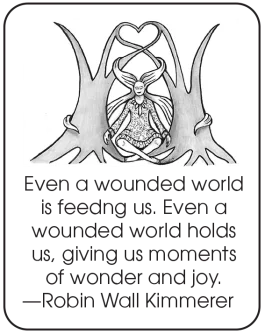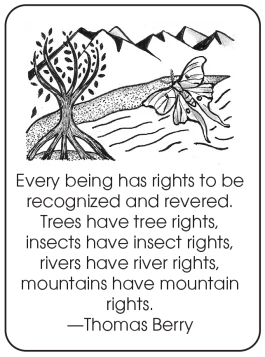
I’ll admit that I sometimes find Spring garden inspiration hard to come by. I find that’s especially true with vegetables, since I’m often starting seeds while there is still snow falling gently from the clouds and I have to scrape ice from my car windshield. Starting seeds truly is an exercise in faith.
When I think about it, though, it’s the bulbs that go in the ground in autumn that really test how much Spring garden inspiration you have. Whether it’s garlic or tulips, there’s something about planting right before Winter that feels so strange to me. And yet, each Spring, daffodils open their beautiful faces to the early Spring sun and tulips celebrate the most brilliant colors.
But there’s another reason to appreciate our Spring gardens. In One Garden at a Time, Diana Wells gives us a brief history of the push and pull between nature and industry, with gardeners square in the middle. “We can create small sanctuaries for birds and butterflies, flowers and trees, one plot at a time. Small, yes, but added up maybe more powerful than we think,” she writes.
That, to me, seems like reason enough to put aside my doubts and get those bulbs in the ground or those seeds into some warm, indoor soil.
Whether It’s Spring Garden Inspiration, or Entertaining Garden History, Read More Gardening Stories in GreenPrints
This story comes from our archive that spans over 30 years and includes more than 130 magazine issues of GreenPrints. I love pieces like these that teach me some interesting facts, but also bring those facts to life and make them relevant for my daily trip to the garden. I hope you enjoy this story as well.

One Garden at a Time
Can gardening help?
By Diana Wells

The root word for “Spring” is springan (Middle English), meaning to “jump up.” It can mean a source of water, or a trap or coil, but for us gardeners it portrays a longed-for burst of life jumping up after the sleep of Winter.
We’re usually ready for it before it actually arrives: Mrs. C.W. Earle in her 1897 Pot Pourri for a Surrey Garden imagined unseen bulbs “firmly and strongly pushing through the cold brown earth; nothing in all the year gives such a sense of power and joy.” How right she was, and certainly we gardeners appreciate Spring. But do we take Spring, like many miracles, for granted?
John Clare, a l9th century laborer and poet, wrote:
The trees still deepen in their bloom
Grass green the meadow lands
And flowers with every morning come
As dropt by fairy hands.

His joy, though, was mingled with distrust of what was happening to the world outside his garden. Enclosure was turning the wild countryside into controlled fields. Industrial progress included railways and new factories. His poetry reflects not only the beauty but also the poignant fragility of the natural world, and poor John Clare ended his life in an asylum for the insane.

In 1864, the year Clare died, an American, George Perkins Marsh, published Man and Nature. This was an attempt to warn his contemporaries that damaging the balance of nature, particularly by cutting down too many trees and overgrazing land, would have disastrous consequences. His book sold well and encouraged an era of “loving nature,” but in spite of all this, 150 years later, we are hearing the same pleas and warnings.

Here, where I live, the long, brown Winters are followed by a brilliance reminiscent of John Clare’s joy when “grass greens the meadow land.” But here, the brightness of the green I see all over is too often that of lawns doctored with chemicals.
All we gardeners love nature—we wouldn’t be gardening if we did not. But how to control and keep balance at the same time? Without controlled spaces, Nature springs—and goes on springing, regardless of our plans! But we are being warned that taking over the Earth, disregarding its balances, can only lead to disaster. We are fearful.

As I watch my bulbs come up, appearing like flowers planted “by fairy hands,” I am joyful—but fearful, too. I am fearful that we take the miracle of Spring, the beauty of the Earth, for granted.

I am cursed with fear, but perhaps blessed with some hope, as well. For I am remembering the millions of gardeners and their gardens, criss-crossing the continent and the world itself. Added up, maybe we can control some of Nature’s balance. We can create small sanctuaries for birds and butterflies, flowers and trees, one plot at a time. Small, yes, but added up maybe more powerful than we think. One garden at a time, we can respect and embrace the living force of Nature, the irresistible spring of life. Apart, but together, maybe we gardeners can rejoice in Spring, as poets and gardeners have rejoiced since poetry and gardening began.
For truly not only do we need Spring, but Spring needs us, as well. ❖
The boxed quotes are all reprinted from Forest Bathing Retreat by Hannah Fries. Published by Storey Publishing.
By Diana Wells, published originally in 2019, in GreenPrints Issue #117. Illustrated by Blanche Derby

What do you look to for inspiration when it seems far too early to start planting your garden?




We all too readily forget that we are caretakers of the earth, our home designed by our Creator to keep us in optimal nutitional health that leads to joy and energy for expanding its beauty. We have deprived the earth of the respect and attention needed to the point where it is too weak to keep the cycle of life for all living things at its best. I do hope that doing my small part in my small space will bring a measure of joy to our Heavenly Father, as His tears seem to be flooding many parts of the planet these days. Thank you for sharing your knowledge to help us improve our efforts.